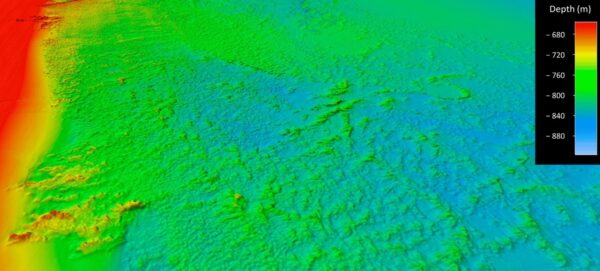Covering 6.4 million acres, an underwater seascape of cold-water coral mounds off the southeast United States coast has been deemed the largest deep-sea coral reef habitat discovered to date, according to a paper recently published in the scientific journal Geomatics.
The reef extends for about 310 miles from Florida to South Carolina and at some points reaches 68 miles wide.
The reef was found at depths ranging from 655 feet to 3,280 feet (200 meters to 1,000 meters), where sunlight cannot penetrate. Unlike tropical coral reefs, where photosynthesis is important for growth, coral this far down must filter food particles out of the water for energy.
Deep coral reefs provide habitat for sharks, swordfish, sea stars, octopus, shrimp and many other kinds of fish, the scientists said.
Example of seafloor multibeam bathymetry data showing the coral mound features located on the Blake Plateau. Image courtesy of NOAA / Sowers, et al.
New mapping reveals true extent
While researchers have known since the 1960s that some coral were present off the Atlantic, the reef’s size remained a mystery until new underwater mapping technology made it possible to construct 3D images of the ocean floor.
The team at the National Oceanic and Atmospheric Administration (NOAA) in the US led the discovery and mapping.
“For years we thought much of the Blake Plateau was sparsely inhabited, soft sediment, but after more than 10 years of systematic mapping and exploration, we have revealed one of the largest deep-sea coral reef habitats found to date anywhere in the world,” said Kasey Cantwell, operations chief for NOAA Ocean Exploration, in a statement.
Cantwell said that past studies had highlighted some coral in the region but that scientists did not know how extensive the habitat was until now.
“This discovery highlights the importance of exploring our deepwater backyard and the power of interagency collaboration and public-private partnerships,” Cantwell said.
Vast reef habitat
The reef habitat is vast – nearly the size of Florida. It’s thought to consist of nearly continuous coral mound features that span up to 500 km (310 miles) long and 110 km (68 miles) wide, with a core area of high-density mounds up to 254 km (158 miles) long and 42 km (26 miles) wide.
The full paper in the journal Geomatics can be read here.
